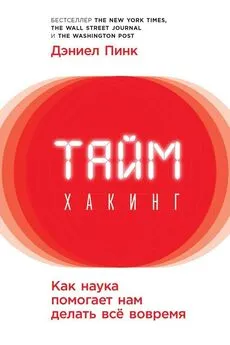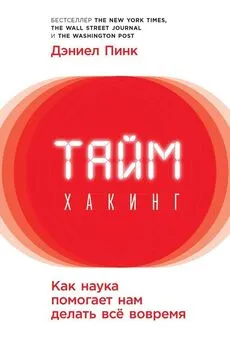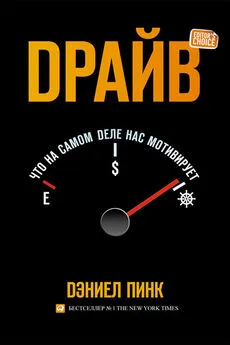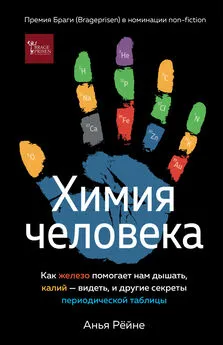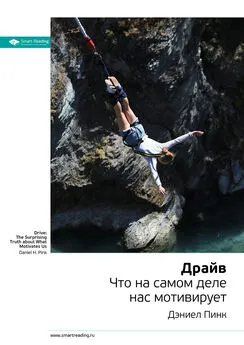Дэниель Пинк - Таймхакинг. Как наука помогает нам делать всё вовремя
- Название:Таймхакинг. Как наука помогает нам делать всё вовремя
- Автор:
- Жанр:
- Издательство:Литагент Альпина
- Год:2018
- Город:Москва
- ISBN:978-5-9614-1515-5
- Рейтинг:
- Избранное:Добавить в избранное
-
Отзывы:
-
Ваша оценка:
Дэниель Пинк - Таймхакинг. Как наука помогает нам делать всё вовремя краткое содержание
Таймхакинг. Как наука помогает нам делать всё вовремя - читать онлайн бесплатно ознакомительный отрывок
Интервал:
Закладка:
277
Roy F. Baumeister and Mark R. Leary, “The Need to Belong: Desire for Interpersonal Attachments as a Fundamental Human Motivation,” Psychological Bulletin 117, no. 3 (1995): 497–529.
278
See C. Nathan DeWall et al., “Belongingness as a Core Personality Trait: How Social Exclusion Influences Social Functioning and Personality Expression,” Journal of Personality 79, no. 6 (2011): 1281–1314.
279
Dan Monster et al., “Physiological Evidence of Interpersonal Dynamics in a Cooperative Production Task,” Physiology & Behavior 156 (2016): 24–34.
280
Michael Bond and Joshua Howgego, “I Work Therefore I Am,” New Scientist 230, no. 3079 (2016): 29–32.
281
Oday Kamal, “What Working in a Kitchen Taught Me About Teams and Networks,” The Ready , April 1, 2016. (Электронная версия: https://medium.com/the-ready/schools-don-t-teach-you-organization-professional-kitchens-do-7c6cf5145c0a#.jane98bnh.)
282
Michael W. Kraus, Cassy Huang, and Dacher Keltner, “Tactile Communication, Cooperation, and Performance: An Ethological Study of the NBA,” Emotion 10, no. 5 (2010): 745–749.
283
Björn Vickhoff et al., “Music Structure Determines Heart Rate Variability of Singers,” Frontiers in Psychology 4 (2013): 1–16.
284
James A. Blumenthal, Patrick J. Smith, and Benson M. Hoffman, “Is Exercise a Viable Treatment for Depression?” ACSM’s Health & Fitness Journal 16, no. 4 (2012): 14–21.
285
Daniel Weinstein et al., “Singing and Social Bonding: Changes in Connectivity and Pain Threshold as a Function of Group Size,” Evolution and Human Behavior 37, no. 2 (2016): 152–158; Bronwyn Tarr, Jacques Launay, and Robin I. M. Dunbar, “Music and Social Bonding: ‘Self-Other’ Merging and Neurohormonal Mechanisms,” Frontiers in Psychology 5 (2014), 1–10; Björn Vickhoff et al., “Music Structure Determines Heart Rate Variability of Singers,” Frontiers in Psychology 4 (2013): 1–16.
286
Stephen M. Clift and Grenville Hancox, “The Perceived Benefits of Singing: Findings from Preliminary Surveys of a University College Choral Society,” Perspectives in Public Health 121, no. 4 (2001): 248–256; Leanne M. Wade, “A Comparison of the Effects of Vocal Exercises/Singing Versus Music-Assisted Relaxation on Peak Expiratory Flow Rates of Children with Asthma,” Music Therapy Perspectives 20, no. 1 (2002): 31–37.
287
Daniel Weinstein et al., “Singing and Social Bonding: Changes in Connectivity and Pain Threshold as a Function of Group Size,” Evolution and Human Behavior 37, no. 2 (2016): 152–158; Gene D. Cohen et al., “The Impact of Professionally Conducted Cultural Programs on the Physical Health, Mental Health, and Social Functioning of Older Adults,” Gerontologist 46, no. 6 (2006): 726–734.
288
Christina Grape et al., “Choir Singing and Fibrinogen: VEGF, Cholecystokinin and Motilin in IBS Patients,” Medical Hypotheses 72, no. 2 (2009): 223–225.
289
R. J. Beck et al., “Choral Singing, Performance Perception, and Immune System Changes in Salivary Immunoglobulin A and Cortisol,” Music Perception 18, no. 1 (2000): 87–106.
290
Daisy Fancourt et al., “Singing Modulates Mood, Stress, Cortisol, Cytokine and Neuropeptide Activity in Cancer Patients and Carers,” Ecancermedicalscience 10 (2016): 1–13.
291
Daniel Weinstein et al., “Singing and Social Bonding: Changes in Connectivity and Pain Threshold as a Function of Group Size,” Evolution and Human Behavior 37, no. 2 (2016): 152–158; Daisy Fancourt et al., “Singing Modulates Mood, Stress, Cortisol, Cytokine and Neuropeptide Activity in Cancer Patients and Carers,” Ecancermedicalscience 10 (2016): 1–13; Stephen Clift and Grenville Hancox, “The Significance of Choral Singing for Sustaining Psychological Wellbeing: Findings from a Survey of Choristers in England, Australia and Germany,” Music Performance Research 3, no. 1 (2010): 79–96; Stephen Clift et al., “What Do Singers Say About the Effects of Choral Singing on Physical Health? Научный доклад о результатах опроса хористов в Австралии, Англии и Германии был представлен на VII конференции Европейского общества музыкальной когнитивистики (Ювяскюля, Финляндия, 2009).
292
Ahmet Munip Sanal and Selahattin Gorsev, “Psychological and Physiological Effects of Singing in a Choir,” Psychology of Music 42, no. 3 (2014): 420–429; Lillian Eyre, “Therapeutic Chorale for Persons with Chronic Mental Illness: A Descriptive Survey of Participant Experiences,” Journal of Music Therapy 48, no. 2 (2011): 149–168; Audun Myskja and Pal G. Nord, “The Day the Music Died: A Pilot Study on Music and Depression in a Nursing Home,” Nordic Journal of Music Therapy 17, no. 1 (2008): 30–40; Betty A. Baily and Jane W. Davidson, “Effects of Group Singing and Performance for Marginalized and Middle-Class Singers,” Psychology of Music 33, no. 3 (2005): 269–303; Nicholas S. Gale et al., “A Pilot Investigation of Quality of Life and Lung Function Following Choral Singing in Cancer Survivors and Their Carers,” Ecancermedicalscience 6, no. 1 (2012): 1–13.
293
Jane E. Southcott, “And as I Go, I Love to Sing: The Happy Wanderers, Music and Positive Aging,” International Journal of Community Music 2, no. 2–3 (2005): 143–56; Laya Silber, “Bars Behind Bars: The Impact of a Women’s Prison Choir on Social Harmony,” Music Education Research 7, no. 2 (2005): 251–271.
294
Nick Alan Joseph Stewart and Adam Jonathan Lonsdale, “It’s Better Together: The Psychological Benefits of Singing in a Choir,” Psychology of Music 44, no. 6 (2016): 1240–1254.
295
Bronwyn Tarr et al., “Synchrony and Exertion During Dance Independently Raise Pain Threshold and Encourage Social Bonding,” Biology Letters 11, no. 10 (2015).
296
Emma E. A. Cohen et al., “Rowers’ High: Behavioural Synchrony Is Correlated with Elevated Pain Thresholds,” Biology Letters 6, no. 1 (2010): 106–108.
297
Daniel James Brown, The Boys in the Boat: Nine Americans and Their Epic Quest for Gold at the 1936 Berlin Olympics (New York: Penguin Books, 2014), 48.
298
Sally Blount and Gregory A. Janicik, “Getting and Staying In-Pace: The ‘In-Synch’ Preference and Its Implications for Work Groups,” in Harris Sondak, Margaret Ann Neale, and E. Mannix, eds., Toward Phenomenology of Groups and Group Membership , vol. 4 (Bingley, UK: Emerald Group Publishing, 2002), 235–266; см. также: Reneeta Mogan, Ronald Fischer, and Joseph A. Bulbulia, “To Be in Synchrony or Not? A Meta-Analysis of Synchrony’s Effects on Behavior, Perception, Cognition and Affect,” Journal of Experimental Social Psychology 72 (2017): 13–20; Sophie Leroy et al., “Synchrony Preference: Why Some People Go with the Flow and Some Don’t,” Personnel Psychology 68, no. 4 (2015): 759–809.
299
Stefan H. Thomke and Mona Sinha, “The Dabbawala System: On-Time Delivery, Every Time,” Harvard Business School case study, 2012. (Электронная версия: на http://www.hbs.edu/faculty/Pages/item.aspx?num=38410.)
300
Bahar Tunçgenç and Emma Cohen, “Interpersonal Movement Synchrony Facilitates Pro-Social Behavior in Children’s Peer-Play,” Developmental Science (готовится к печати).
301
Bahar Tunçgenç and Emma Cohen, “Movement Synchrony Forges Social Bonds Across Group Divides,” Frontiers in Psychology 7 (2016): 782.
302
Tal-Chen Rabinowitch and Andrew N. Meltzoff, “Synchronized Movement Experience Enhances Peer Cooperation in Preschool Children,” Journal of Experimental Child Psychology 160 (2017): 21–32.
303
Duncan Watts, “Using Digital Data to Shed Light on Team Satisfaction and Other Questions About Large Organizations,” Organizational Spectroscope , April 1, 2016. (Электронная версия: https://medium.com/@duncanjwatts/the-organizational-spectroscope-7f9f239a897c.)
304
Gregory M. Walton and Geoffrey L. Cohen, “A Brief Social-Belonging Intervention Improves Academic and Health Outcomes of Minority Students,” Science 331, no. 6023 (2011): 1447–14451; Gregory M. Walton et al., “Two Brief Interventions to Mitigate a ‘Chilly Climate’ Transform Women’s Experience, Relationships, and Achievement in Engineering,” Journal of Educational Psychology 107, no. 2 (2015): 468–485.
305
Lily B. Clausen, “Robb Willer: What Makes People Do Good?” Insights by Stanford Business , November 16, 2015 (Электронная версия: https://www.gsb.stanford.edu/insights/robb-willer-what-makes-people-do-good.)
306
Но стопроцентной уверенности в том, что Граучо этого не говорил, тоже нет. См.: Fred R. Shapiro, The Yale Book of Quotations (New Haven, CT: Yale University Press, 2006), 498.
307
Anthony G. Oettinger, “The Uses of Computers in Science,” Scientific American 215, no.3 (1966): 161–166.
308
Frederick J. Crosson, Human and Artificial Intelligence (New York: Appleton-Century-Crofts, 1970), 15.
309
Fred R. Shapiro, The Yale Book of Quotations (New Haven, CT: Yale University Press, 2006), 498.
310
“The Popularity of ‘Time’ Unveiled,” BBC News, June 22, 2006. (Электронная версия: http://news.bbc.co.uk/2/hi/uk_new/5104778.stm.) См. также: Alan Burdick, Why Time Flies: A Mostly Scientific Investigation (New York: Simon & Schuster, 2017), 25.
311
Увлекательное описание истории изучения ностальгии, а также источники этих цитат, см.: Constantine Sedikides et al., “To Nostalgize: Mixing Memory with Affect and Desire,” Advances in Experimental Social Psychology 51 (2015): 189–273.
312
Tim Wildschut et al., “Nostalgia: Content, Triggers, Functions,” Journal of Personality and Social Psychology 91, no. 5 (2006): 975–993.
313
Clay Routledge et al., “The Past Makes the Present Meaningful: Nostalgia as an Existential Resource,” Journal of Personality and Social Psychology 101, no. 3 (2011): 638–622; Wijnand A. P. van Tilburg, Constantine Sedikides, and Tim Wildschut, “The Mnemonic Muse: Nostalgia Fosters Creativity Through Openness to Experience,” Journal of Experimental Social Psychology 59 (2015): 1–7.
Читать дальшеИнтервал:
Закладка:
